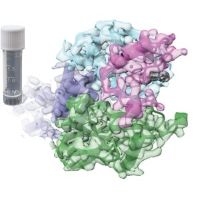Specification
| Description | Recombinant protein from the full-length sequence of Homo sapiens ring finger protein 34 (RNF34), transcript variant 2 (NM_025126). |
| Organism | Homo sapiens (Human) |
| Expression Host | Human Cells |
| Tag Info | His or DYKDDDDK. Please contact us if you need further information or require specific designed tag. |
| Purity | Greater than 90% by SDS-PAGE gel |
| Uniprot ID | Q969K3 |
| Entry Name | RNF34_HUMAN |
| Gene Names | RNF34 |
| Alternative Gene Names | |
| Alternative Protein Names | E3 ubiquitin-protein ligase RNF34 (EC 2.3.2.27) (Caspase regulator CARP1) (Caspases-8 and -10-associated RING finger protein 1) (CARP-1) (FYVE-RING finger protein Momo) (Human RING finger homologous to inhibitor of apoptosis protein) (hRFI) (RING finger protein 34) (RING finger protein RIFF) (RING-type E3 ubiquitin transferase RNF34) |
| Application | Antigens, Western, ELISA and other in vitro binding or in vivo functional assays, and protein-protein interaction studies; For research & development use only! |
| Buffer | Purified protein formulated in a sterile solution of PBS buffer, pH7.2, without any preservatives |
| Endotoxin | Endotoxin level is < 0.1 ng/µg of protein (<1EU /µg) |
| Length | 372 |
| Molecular Weight(Da) | 41641 |
| Protein Sequence | (The sequence of expressed protein may have some variation from the sequence shown below. Please contact us for the exact sequence.) MKAGATSMWASCCGLLNEVMGTGAVRGQQSAFAGATGPFRFTPNPEFSTYPPAATEGPNIVCKACGLSFSVFRKKHVCCDCKKDFCSVCSVLQENLRRCSTCHLLQETAFQRPQLMRLKVKDLRQYLILRNIPIDTCREKEDLVDLVLCHHGLGSEDDMDTSSLNSSRSQTSSFFTRSFFSNYTAPSATMSSFQGELMDGDQTSRSGVPAQVQSEITSANTEDDDDDDDEDDDDEEENAEDRNPGLSKERVRASLSDLSSLDDVEGMSVRQLKEILARNFVNYSGCCEKWELVEKVNRLYKENEENQKSYGERLQLQDEEDDSLCRICMDAVIDCVLLECGHMVTCTKCGKRMSECPICRQYVVRAVHVFKS |
Background
| Function | FUNCTION: E3 ubiquitin-protein ligase that regulates several biological processes through the ubiquitin-mediated proteasomal degradation of various target proteins. Ubiquitinates the caspases CASP8 and CASP10, promoting their proteasomal degradation, to negatively regulate cell death downstream of death domain receptors in the extrinsic pathway of apoptosis (PubMed:15069192). May mediate 'Lys-48'-linked polyubiquitination of RIPK1 and its subsequent proteasomal degradation thereby indirectly regulating the tumor necrosis factor-mediated signaling pathway (Ref.13). Negatively regulates p53/TP53 through its direct ubiquitination and targeting to proteasomal degradation (PubMed:17121812). Indirectly, may also negatively regulate p53/TP53 through ubiquitination and degradation of SFN (PubMed:18382127). Mediates PPARGC1A proteasomal degradation probably through ubiquitination thereby indirectly regulating the metabolism of brown fat cells (PubMed:22064484). Possibly involved in innate immunity, through 'Lys-48'-linked polyubiquitination of NOD1 and its subsequent proteasomal degradation (PubMed:25012219). {ECO:0000269|PubMed:12118383, ECO:0000269|PubMed:15069192, ECO:0000269|PubMed:15897238, ECO:0000269|PubMed:17121812, ECO:0000269|PubMed:22064484, ECO:0000269|PubMed:25012219, ECO:0000269|Ref.13, ECO:0000303|PubMed:18382127}. |
| Pathway | Protein modification; protein ubiquitination. |
| Protein Families | |
| Tissue Specificity | Ubiquitous. Detected in heart, brain, liver, skeletal muscle, kidney, pancreas, spleen, thymus, prostate, testis, ovary, colon and leukocytes. {ECO:0000269|PubMed:12118383, ECO:0000269|PubMed:15069192}. |
QC Data
| Note | Please contact us for QC Data |
| Product Image (Reference Only) |  |

